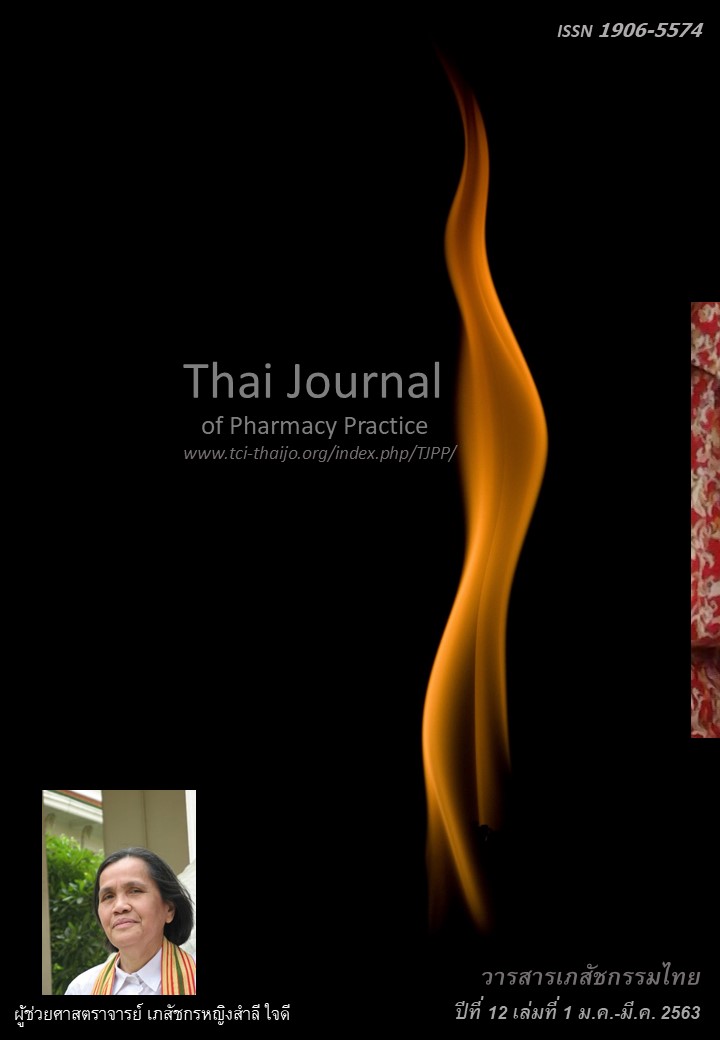ความเฉื่อยทางคลินิกในผู้ป่วยเบาหวานชนิดที่ 2 ในโรงพยาบาลชุมชน จังหวัดอุบลราชธานี
Main Article Content
บทคัดย่อ
วัตถุประสงค์: เพื่อศึกษาระยะเวลาที่ผู้ป่วยเบาหวานชนิดที่ 2 ที่รักษาด้วยยารักษาเบาหวานชนิดรับประทานแล้วเกิดความเฉื่อยทางคลินิก โดยเทียบกับแนวทางเวชปฏิบัติสำหรับโรคเบาหวาน และหาปัจจัยที่มีความสัมพันธ์กับการเกิดความเฉื่อยทางคลินิก วิธีการ: การศึกษาแบบ retrospective cohort study ครั้งนี้ใช้ข้อมูลเวชระเบียนอิเล็กทรอนิกส์ของผู้ป่วยเบาหวานชนิดที่ 2 รายใหม่ที่มารับการรักษาในโรงพยาบาลชุมชนจำนวน 16 แห่งในจังหวัดอุบลราชธานี ระหว่างวันที่ 1 มิถุนายน 2551 ถึง 31 ธันวาคม 2558 ข้อมูลหลัก คือ ระดับน้ำตาลในเลือดหลังอดอาหารและชนิดของยารักษาเบาหวานที่ผู้ป่วยได้รับในวันที่มารับบริการ เพื่อหาผู้ป่วยที่เกิดความเฉื่อยทางคลินิกซึ่งหมายถึงผู้ป่วยที่ไม่ได้รับการรักษาเพิ่มขึ้นจากการรักษาเดิมเมื่อผลการรักษาที่ได้ไม่เป็นไปตามเป้าหมายในการรักษาตามแนวทางเวชปฏิบัติสำหรับสำหรับโรคเบาหวานปี พ.ศ. 2551 พ.ศ. 2554 และปี พ.ศ. 2557 การหาปัจจัยที่มีความสัมพันธ์กับการเกิดความเฉื่อยทางคลินิกใช้การวิเคราะห์ถดถอยโลจิสติค
ผลการศึกษา: ในผู้ป่วยเบาหวานชนิดที่ 2 ที่ผ่านเกณฑ์การคัดเลือกจำนวน 15,228 ราย ผู้ป่วยเกิดภาวะความเฉื่อยทางคลินิก 5,903 ราย (ร้อยละ 38.76) ผู้ป่วยที่เข้ารับการรักษาช่วงวันที่ 1 มิถุนายน 2551 – 31 ธันวาคม 2553 (ระยะที่ 1) วันที่ 1 มกราคม 2554 – 31 ธันวาคม 2556 (ระยะที่ 2) วันที่ 1 มกราคม 2557 – 31 ธันวาคม 2558 (ระยะที่ 3) มีระยะเวลาเฉลี่ยตั้งแต่เริ่มรักษาจนเกิดความเฉื่อยทางคลินิกครั้งแรกเฉลี่ย 377.7 ± 5.46 วัน 348.75 ± 3.39 วัน และ 316.75 ± 3.62 วันตามลำดับ สัดส่วนผู้ป่วยเบาหวานที่เกิดความเฉื่อยทางคลินิกอย่างน้อย 1 ครั้ง คือ ร้อยละ 19.35 ร้อยละ 32.61 ร้อยละ 42.73 ในระยะที่ 1 ถึง 3 ตามลำดับ ปัจจัยที่มีความสัมพันธ์อย่างนัยมีสำคัญทางสถิติกับการเกิดความเฉื่อยทางคลินิกที่น้อยกว่า ได้แก่ ผู้ป่วยที่มีอายุระหว่าง 55 – 62 ปี (OR = 0.75; 95%CI = 0.60 – 0.94) และผู้ป่วยที่มีอายุ 63 ปีขึ้นไป (OR = 0.67; 95%CI = 0.54 – 0.83) ผู้ป่วยเพศหญิง (OR = 0.84; 95%CI = 0.73 – 0.98) ผู้ป่วยที่มีโรคร่วมความดันโลหิตสูง (OR = 0.85; 95%CI = 0.59 – 0.81) ผู้ป่วยเข้าที่เข้ารับการรักษาในโรงพยาบาลสองแห่งในจังหวัด (OR = 0.14; 95%CI = 0.04 – 0.50, OR = 0.52; 95%CI = 0.35 – 0.79) สรุป: ความเฉื่อยทางคลินิกเกิดมากขึ้นและเร็วขึ้นจากช่วงระยะเวลาที่ 1 ถึงระยะเวลาที่ 3 โดยประมาณหนึ่งในสามของผู้ป่วยเบาหวานชนิดที่ 2 เกิดความเฉื่อยทางคลินิก ผู้ป่วยกลุ่มอายุสูง เพศหญิง มีโรคร่วมความดันโลหิตสูง รับการรักษาที่สถานบริการ 2 แห่ง มีความสัมพันธ์กับการเกิดความเฉื่อยทางคลินิกที่น้อยกว่ากลุ่มอื่น ๆ
Article Details
ผลการวิจัยและความคิดเห็นที่ปรากฏในบทความถือเป็นความคิดเห็นและอยู่ในความรับผิดชอบของผู้นิพนธ์ มิใช่ความเห็นหรือความรับผิดชอบของกองบรรณาธิการ หรือคณะเภสัชศาสตร์ มหาวิทยาลัยสงขลานครินทร์ ทั้งนี้ไม่รวมความผิดพลาดอันเกิดจากการพิมพ์ บทความที่ได้รับการเผยแพร่โดยวารสารเภสัชกรรมไทยถือเป็นสิทธิ์ของวารสารฯ
เอกสารอ้างอิง
2. Bureau of Health Policy and Strategy. Public health statistic. Nonthaburi: Ministry of Public Health; 2013
3. Khoury JC, Kleindorfer D, Alwell K, Moomaw CJ, Woo D, Adeoye O, et al. Diabetes mellitus: a risk factor for ischemic stroke in a large bi-racial population. Stroke 2013; 44: 1500-4.
4. Ratanasan C. Impact of diabetes in Thailand [online]. 2014 [cited Dec 16, 2015]. Available from: i-regist.igenco.co.th/web/dmthai_old/news_and_kno wledge/371.
5. Potisat S, Krairittichai U, Jongsareejit A, Sattaputh C, Arunratanachote W. A 4-year prospective study on long-term complications of type 2 diabetic patients: the Thai DMS diabetes complications (dd.comp.) project. J Med Assoc Thai 2013; 96: 637-43.
6. World Health Organization. About diabetes [online]. 2014 [cited Jul 27, 2015]. Available from: www. who.int/diabetes/en/.
7. Diabetes Association of Thailand, The Endocrine Society of Thailand, Department of Medical Services, National Health Security Office. Clinical practice guideline for diabetes 2011. Bangkok: Srimuang printing; 2011.
8. O’Connor PJ, Sperl-Hillen JM, Johnson PE, Rush WA, Biltz G. Clinical inertia and outpatient medical errors. J Med Licens Discip 2008; 94: 19-29.
9. Rangsin R, Tasanawiwat P, MedResNet group. An assessment on quality of care among patients diagnosed with type 2 diabetes and hypertension visiting ministry of public health and Bangkok metropolitan administration hospitals in Thailand, 2012 [online]. 2014 [cited Aug 8, 2015]. Available from: www.thaincd.com/2016/mission/documents-de tail.php?id=12363&tid=&gid=1-027.
10. Aujoulat I, Jacquemin P, Rietzschel E, Scheen A, Trefois P, Wens J, et al. Factors associated with clinical inertia: an integrative review. Adv Med Educ Pract 2014; 5: 141-7.
11. Lin J, Zhou S, Wei W, Pan C, Lingohr-Smith M, Levin P. Does clinical inertia vary by personalized A1C goal? a study of predictors and prevalence of clinical inertia in a US manage care setting. Endocr Pract 2016; 22: 151-61.
12. Yu S, Schwab P, Bian B, Radican L, Tuncell K. Use of add-on treatment to metformin monotherapy for patients with type 2 diabetes and suboptimal glycemic control: a U.S. database study. J Manag Care Spec Pharm 2016; 22: 272-80.
13. Rajpathak SN, Rajgopalan S, Engel SS. Impact of time to treatment intensification on glycemic goal attainment among patients with type 2 diabetes failing metformin monotherapy. J Diabetes Compli cations 2014; 28: 831-5.
14. McEwen LN, Bilik D, Johnson SL, Halter JB, Karter AJ, Mangione CM, et al. Predictors and impact of intensification of antihyperglycemic therapy in type 2 diabetes. Diabetes Care 2009; 32: 971-6.
15. Lang VB, Markovic BB, Kranjcevic K. Family physician clinical inertia in glycemic control among patients with type 2 diabetes. Med Sci Monit 2015; 21: 403-11.
16. Khunti K, Wolden ML, Thorsted BL, Anderson M, Davies MJ. Clinical inertia in people with type 2 diabetes: a retrospective cohort study of more than 80,000 people. Diabetes Care 2013; 36: 3411-7.
17. Diabetes Association of Thailand, The Endocrine Society of Thailand, Department of Medical Service, Health, National Health Security Office. Clinical practice guideline for diabetes 2008. Bangkok: Rungsin printing 1977; 2008.
18. Diabetes Association of Thailand, The Endocrine Society of Thailand, Department of Medical Service, National Health Security Office. Clinical practice guideline for diabetes 2014. Bangkok: Aroon printing; 2014.


